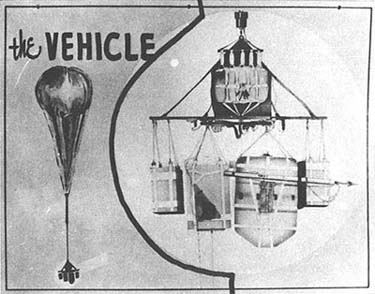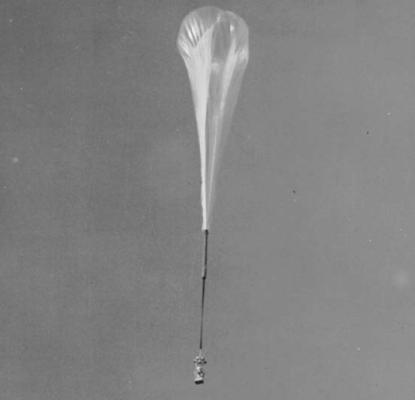 |
WS-119L reconnaissance balloon |
Project Genetrix
The photographic balloon project, designated Project GOPHER/Weapon System 119L in early 1955, had gone through a protracted development phase since its initiation in the fall of 1950. It had been difficult to perfect fabrication and launching techniques for the enormous, fragile polyethylene envelopes. Vast numbers of "Moby Dick" and "Grandson" prototype balloons had traversed the skies of North America as Air Force meteorologists slowly gathered data on the nature of air currents at extreme altitudes. Effective camera systems and ballast control equipment had taken years to develop. Elaborate techniques had been evolved to recover the camera package during its descent. The balloons were equipped with radio beacons that would be activated by timers based on the predicted transit time of Soviet airspace. Once the beacon switched on, a specially equipped Air Force C-119 "Flying Boxcar" recovery plane would home in and begin circling far below. The balloon gondola was equipped with a device that would cut the camera package free by radio command, and the falling gondola, slowed by parachute, would be literally snatched out of the sky by grapples trailed from the C-119. RAND analysts, who were well aware of the red-hot connection between balloons and UFO reports, advised the Air Force that the most effective way to use WS-119L would be to launch hundreds of the balloons in waves over a period of just a few weeks. This would maximize the photographic coverage that the balloons could obtain while keeping the Soviets off balance. A short operational period would give its armed forces less time to rally defenses against the vehicles, particularly if the command and control system was confused by the bewildering sightings that the balloons were known to spawn.
 |
Plastic balloon at high altitude, 1950
US Navy |
The system and its associated tracking and recovery squadrons were deemed ready for deployment in the summer of 1955, soon after the Soviet rejection of the Open Skies proposal. Under cover of the ostensibly scientific Moby Dick project, WS-119L tracking sites were set up in Guam, the Philippines, Midway, Okinawa, Japan, and Alaska. By the end of October, 2,500 balloons and their launch crews were moved to five launch sites in Europe: Gardermoen, Norway; Evanton, Scotland; Oberpfaffenhofen and Giebelstadt, West Germany; and Incirlik, Turkey. A few days later fifty C-119 recovery planes were deployed to Okinawa, Japan and Alaska. By the end of November, a hemisphere-wide network of balloon launching, tracking and recovery sites surrounded the Soviet Union. The project's code name was changed to "Genetrix," and the launch facilities stood by for orders to begin the operation. In view of the great sensitivity of the project, permission to commence the overflights would come directly from President Eisenhower, who was far from enthusiastic about the use of what he considered "dirty trick" reconnaissance techniques.
Since late summer, to help provide cover for WS-119L, a CIA front-organization, the National Committee for a Free Europe, which ran Radio Free Europe, had been launching hundreds of small balloons carrying propaganda leaflets into the skies over eastern Europe, much to the consternation of the Soviets. Then, on January 9, 1956, at State Department request, the Air Force began a well-publicized series of "White Cloud" weather balloon flights to further blur the balloon story. The White Cloud vehicles were virtually identical to the Genetrix reconnaissance devices with the exception of their gondolas, which contained only scientific equipment. A press release was then issued explaining that similar balloons would soon be launched carrying cameras "to photograph clouds." After a final conference with Secretary of State John Foster Dulles and assurances from Donald Quarles that the potential benefits of the reconnaissance project were worth the risks, Eisenhower reluctantly gave his go-ahead. On January 10, the first wave of Genetrix -- one from West Germany and eight from Turkey -- soared into the stratospheric windstreams to begin their missions. The next day, nine more were launched from Germany. On the 12th, the base in Scotland got one airborne, adding to seven from the German sites. Ten WS-119Ls were launched from the various bases on each of the succeeding four days. On the 17th, the rate was increased to twenty per day. Within two weeks of the outset of the project, over two hundred Genetrix were sent into the the skies over the USSR. By January 13, three balloons, the survivors of the first day's wave, exited Soviet airspace. The gondolas were successfully cut down by radio command and grabbed from the air by C-119s. In the ensuing days, about one Genetrix appeared in the recovery zones for every four launched. Eisenhower and Dulles stood ready for the anticipated Soviet protests. Days dragged into weeks. The Soviets were in a difficult position. While they were obviously enraged by the overflights, they were reluctant to call attention to their vulnerability to such tactics. By the end of January, in the absence of complaints, the Air Force decided to raise the launch rate goal to thirty per day, then forty. On February 3, a Genetrix launched from Gardermoen overflew Oslo. For the next two hours, as the gleaming ovoid drifted overhead, people in the Norwegian capital and its suburbs sent in a bevy of UFO reports.
Behind their facade of official silence, the Soviets were not so easily deceived. They undoubtedly knew that the balloons were coming, but even so, it took time to devise effective tactics for engaging the high-flying intruders. The US had given them one out: at the last minute, the maximum altitude of the WS-119Ls was set at 55,000 feet, and minimum altitude, at which ballast would be automatically dropped to prevent further descent, was programmed at about 49,000 feet. This was at least 15,000 feet below the operating altitudes that the devices were capable of reaching. A MiG-15 fighter straining at full power in the thin air above 50,000 feet would therefore have a brief opportunity to shoot down a Genetrix. The Soviets also had heavy antiaircraft artillery pieces that were capable of lobbing shells to those heights. (Ironically, the Fire Can radars guiding the interceptors and guns were based on Lend-Lease models of the old US SCR-584, the same type used by the Sunset Project to combat the Japanese Fu-Go balloons a decade before, and the same type widely used in the US to track weather balloon RAWIN targets). The Soviets undoubtedly faced the same difficulties as the US Air Force had in detecting and tracking the Japanese Fu-Go and its own plastic balloons, but they quickly realized that the WS-119s were at their most vulnerable minimum altitude when their lifting gas was coolest -- just after dawn and just before sunset, the same hours when low sun angles made their glistening envelopes most conspicuous. The reason for the low cruise altitude setting is unknown. Perhaps Eisenhower felt that the Genetrix overflights would seem less provocative if the Soviets had at least a fighting chance of shooting the devices down.
By exploiting these vulnerabilities, the Soviets soon blunted the Genetrix assault. USAF recovery crews began to note a sharp decline in the numbers exiting Soviet airspace, and by the end of January, no balloons were coming through at all. Launch sites were not meeting daily quotas, and even when Genetrix passed safely into the recovery zones, their command receivers frequently malfunctioned, preventing payload cut-down and retrieval. It was increasingly obvious that the Soviets were well aware of the project. Eisenhower and his advisors were considering termination of the program by the beginning of February. Finally, on February 4, the inevitable happened. Andrei Gromyko, the Soviet deputy Foreign Minister, formally issued a "decisive protest" over the "gross violation of Soviet air space" by "aerial spheres" to the US ambassador in Moscow:
The apparatus suspended from the aerial spheres includes automatic photographic cameras for aerial photography, radio transmitters, radio receivers and other things.... Investigation shows these spheres and their suspended apparatus are manufactured in the United States.
The Air Force responded by pushing its crews to launch as many Genetrix as physically possible. But Eisenhower had had enough. Foster Dulles asked Quarles to halt the operation on the morning of February 6. A few WS-119Ls continued to straggle into recovery areas over the next few days, and while their camera packages were being secured, the State Department piously stuck to the weather balloon cover story:
The U.S. Government is happy to supply information complementary to what is already public knowledge. Under U.S. auspices, a meteorological survey is being carried out by the launching of balloons which are in effect miniature 'satellites' and which remain aloft for several days at a very considerable height...
Brazenly, the statement actually requested that the Soviets return balloon payloads that had fallen within their territory. The US Army and Air Force revealed that Soviet weather balloons had been recovered in Japan and Alaska in recent weeks and offered to exchange them for the US devices. Instead, on the evening of the 9th, in a show of righteous indignation, the Soviets placed the remains of about fifty shredded balloons and gondolas on display outside Molotov's residence in Moscow. They bitterly attacked the US administration for treading perilously close to war by conducting peacetime aerial espionage. Not only could the pirate devices take photographs of the territory of the USSR, but they could carry biological warfare agents, the Soviets angrily charged, in a reference to Project "Flying Cloud."
Four hundred forty eight Genetrix had been launched during the month-long project. Of that number (a fraction of the planned 2,500), forty gondolas were recovered with usable film aboard. These yielded about 13,000 frames showing random areas of the Soviet and Chinese hinterland -- a million square miles of snowy forests, icy lakes, farms, factories and mountains. Reportedly, Genetrix discovered only one target of significance -- a nuclear materials production complex. The results of the secretive but remarkably conspicuous reconnaissance balloon effort, which had provoked so much tragedy, confusion and rumor at home and abroad, seemed barely worth the effort.